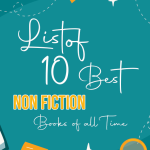Poetry has a timeless charm due to its ability to capture emotions, conjure images, and express deep concepts with simple words. If you love poetry and want to share your rhymes with the world, this book will teach you how to design, compose, and publish your own poems.
We’ll take you through the interesting world of poetry, from writing poems to having your work published, in this blog.
Can you publish a single poem?
You certainly can! Individual poetry submissions are accepted by several print and online magazines. These sites enable young poets to present their work to a larger audience. Open requests for poetry contributions are common in literary publications, journals, and anthologies. To begin, polish your poetry till it shines, and then look for magazines that fit your style and topic. Create an engaging cover letter, follow the submission requirements, and submit your poem for consideration.
You may also like: What Is Contemporary Fiction? Definition, Themes with Examples
How Do I Publish My Own Poetry?
Publishing your poetry can take several forms, depending on your goals and resources:
- Self-publishing: If you wish to maintain complete control over your work, self-publishing is a viable option. You can publish your poetry as a chapbook or a full-length collection through self-publishing platforms like Amazon Kindle Direct Publishing (KDP) or IngramSpark. This route gives you creative freedom and a higher share of royalties but requires investment in editing, cover design, and marketing.
- Traditional Publishing: Traditional publishers, such as established publishing houses or poetry presses, offer a route to wider distribution and recognition. To pursue traditional publishing, prepare a polished poetry manuscript, craft a strong query letter, and research literary agents or publishers that specialise in poetry. Be prepared for the competitive nature of the industry, as it may take time to secure a publishing deal.
You may also like: Literary Fiction vs. Genre Fiction: Definition & Examples
How Much Does It Cost to Publish Poetry?
The cost of publishing poetry varies depending on the publishing path you choose. Here’s a breakdown:
- Self-Publishing: Costs include editing, cover design, formatting, and marketing expenses. These can range from a few hundred to a few thousand dollars, depending on your choices and the extent of services you require.
- Traditional Publishing: Traditional publishers typically cover the costs of editing, design, printing, and distribution. However, you may still need to invest in query submissions, attending writing conferences, or hiring an agent, if applicable.
You may also like: Top 10 Rhetorical Devices Every Writer Should Know
How Do You Publish a Poem for Free?
Publishing your poem for free is achievable through various online platforms and competitions. Here are some ways to get your poetry out there without spending:
- Literary Journals: Online literary journals and magazines provide an excellent platform for poets to share their work. Many of these publications offer free submissions, allowing poets to showcase their creativity without financial barriers. If your poetry gets accepted, it’s exposed to the journal’s readership, potentially reaching a wider audience and gaining recognition. Literary journals are often respected within the writing community, making them a valuable avenue for emerging and established poets to publish their work.
- Poetry Contests: Poetry contests can be an exciting way to challenge your poetic skills and gain recognition. While some contests charge an entry fee, there are reputable ones that don’t require any payment to participate. Keep an eye out for these opportunities, as they often come with attractive prizes, publications, or other forms of recognition. Winning or even being recognised in a no-fee poetry contest can be a significant boost to your writing career, all without the burden of entry costs.
- Blogs and Social Media: In the digital age, creating a blog or sharing your poetry on social media platforms like Instagram or Twitter can be a powerful means to connect with an audience. It’s cost-effective and allows poets to freely express themselves. Blogs can be personalised spaces for poets to share their work and thoughts and engage with readers. Social media platforms, with their wide user base, provide an effective way to reach a broader audience and connect with fellow poets and enthusiasts without incurring any expenses.
You may also like: What is Ghostwriting? A Complete Guide for Beginners
How Do You Publish a Poem Online?
Publishing poetry online is relatively straightforward.
- Create a Blog: Start a poetry blog using platforms like WordPress, Blogger, or Medium. Share your poems, engage with your readers, and build a following over time.
- Social Media: Utilise social media to share your poems. Platforms like Instagram are particularly popular for poets due to their visual nature. Use relevant hashtags to reach a broader audience.
- Literary Websites: Submit your poems to literary websites, forums, or online magazines that accept poetry submissions. This can help you gain exposure and connect with fellow poets.
You may also like: 10 Magical Books That Combine Christmas and Fantasy
How Do You Get a Poem Published?
To increase your chances of getting a poem published, follow these steps:
- Polish Your Work: Before submitting your poem, meticulously review it for grammatical errors, punctuation, and overall clarity. Ensure that your poem is error-free and that every word contributes to its meaning and impact. Revise and refine your poem until it shines with your intended message, evoking the emotions and imagery you desire.
- Research Publications: Explore literary magazines, journals, and anthologies that align with your poem’s style, theme, and tone. Read their submission guidelines carefully to understand their specific requirements and preferences. Tailoring your submissions to the right publications increases the likelihood of acceptance.
- Prepare a Cover Letter: Craft a professional and concise cover letter to accompany your poem submission. In your cover letter, briefly introduce yourself as a poet and provide a succinct description of your poem’s inspiration or themes. Ensure that your cover letter adheres to the submission guidelines of the publication you’re targeting.
- Submit Widely: Increase your chances of publication by submitting your poem to multiple publications simultaneously. Keep a detailed record of each submission, including the date, publication name, and any specific guidelines you followed. This organised approach allows you to efficiently manage your submissions and track responses.
- Be persistent. Rejections are a common part of the publishing journey for poets. It’s essential to maintain persistence and resilience in the face of rejection. View each rejection as an opportunity to learn and grow as a writer. Keep submitting your work, revising it as needed, and refining your craft. Persistence often leads to eventual success in the competitive world of poetry publishing.
You may also like: How to Publish a Book? | Publish Your Book | BlueRoseOne
How Do I Get a Poem Published?
Getting a poem published often requires patience and persistence. Here’s a summarised approach:
- Refine Your Poem: After drafting your poem, take the time to edit and refine it meticulously. Ensure it adheres to your chosen publication’s style, whether that’s a preference for certain themes, tones, or poetic forms. This step is crucial to making your work more appealing to editors and increasing your chances of acceptance. It demonstrates your commitment to producing quality work that aligns with the publication’s vision.
- Find Suitable Outlets: Research is key. Look for literary journals, magazines, or anthologies that have a track record of publishing poems similar to yours in terms of style, subject matter, or tone. Each publication has its own unique identity, and identifying those that resonate with your poetry increases your chances of success. Tailoring your submissions to outlets that align with your work saves time and resources.
- Prepare Submissions: Pay close attention to submission guidelines. These guidelines may specify formatting, cover letters, or submission fees. Ensure your submission is in the prescribed format and that your cover letter is professional and engaging. Meeting these requirements not only demonstrates your professionalism but also ensures your submission is seriously considered.
- Submit and Track: Send your poem to multiple publications simultaneously to maximise your chances of acceptance. Keep a detailed record of your submissions, including where and when you submitted them, response times, and any feedback you receive. Tracking your submissions helps you manage the process effectively, and it’s essential for avoiding simultaneous submissions, which some journals prohibit.
- Persist and Adapt: Be prepared for rejection; it’s a common part of a poet’s journey. Don’t be disheartened by rejection letters. Instead, use them as opportunities to revise, refine, and improve your craft. Be open to feedback from editors or peers, and adapt your work accordingly. Persistence and a willingness to adapt are key qualities for poets seeking to grow and find their place in the world of publication.
In conclusion, poetry offers a unique channel for self-expression, and publishing your poems allows you to share your creativity with the world. Whether you opt for traditional publishing, self-publishing, or sharing your work online, remember that persistence, dedication, and continuous improvement are key to success in the world of poetry.
Read: How to pick between Paperback, Hardcover, Ebook – What’s best for you?
Embrace the joy of writing and sharing your verses, for poetry has the power to touch hearts and souls in profound ways.
Publish your book with BlueRoseONE and become a bestselling author. Don’t let your dream of becoming an author fade away, grab the opportunity now and publish your book – be it fiction, non fiction, poetry or more.
















